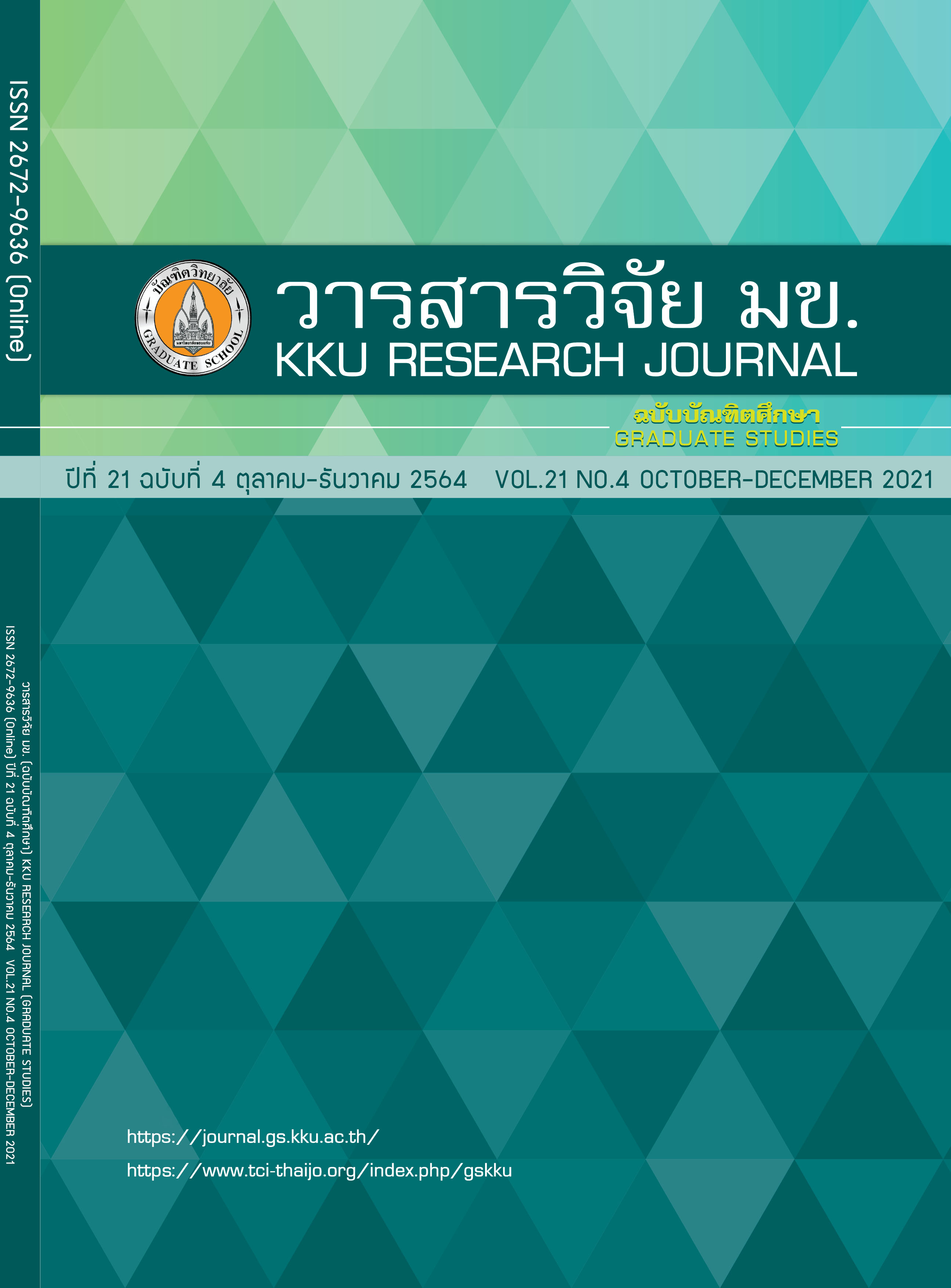Water Sanitation Practices of People and Bacteriological Quality of Water in Xaychamphone District, Bolikhamxay Province, Lao PDR
Keywords:
Water sanitation practices, Bacteriological quality of water, Lao PDRAbstract
This study is survey study cross-sectional research. To study the water sanitation practices of people and the bacteriological quality of water in Xaychamphone district, Bolikhamxay province, Lao PDR, Amount 314 households, tools for an interview, survey, record, and test kit for coliform in water (DOH. 11). The results showed that the supply of drinking water is the heads of households 57.32%. taking time to go back and forth from the house to find the water source in average 4.69±5.80 minutes, The main source is mountain water supply was 90.13 %, using a pipeline-based water transport method from the public water tab was 57.01 %, 93.63 % with an improvement in drinking water quality by boiling. In the water sanitation practices of the household (full score of 15) was moderate 63.69%, mean 10.17± 0.68. Monitoring the bacterial water quality of the water source used by the public to consume as a mountain water supply is 100 percent of bacterial coliform contamination was found. Samples of household drinking water were found 87.90 percent of coliform bacteria. The relationship between water sanitation practices of the household and status of water sanitation household with coliform contamination in drinking water was not statistically significant (p-value > 0.05)
References
Prüss-Ustün A, Wolf J, Corvalán C, Neville T, Bos R, Neira M. Diseases due to unhealthy environments: an updated estimate of the global burden of disease attributable to environmental determinants of health. J Public Health Oxf Engl. 2017 01;39(3):464–475.
Wibuloutai J. Water supply and water risk assessment. Maha Sarakham: Environmental Health Faculty of Public Health Maha Sarakham University; 2017. 269 p.
World Health Organization (WHO), United Nations Children’s Fund (UNICEF). Progress on drinking water, sanitation, and hygiene: 2017 update and SDG baselines. Phoenix Design Aid A/S, Denmark. Switzerland: WHO Library Cataloguing-in-Publication Data; 2017.
WHO. Drinking-water [Internet]. 2019 [cited 2019 Aug 29]. Available from: https://www.who.int/en/news-room/fact-sheets/detail/drinking-water
Lao PDR - Ministry of Health. National health statistics report FY 2015-2016. Lao PDR - Ministry of Health: Department of planning and International Cooperation; 2016 p. 84.
Lao PDR - Ministry of Health. 10 Indicator for 18 Provinces and 148 districts in Lao PDR. Vientiane capital; 2019 Jun p. 5. Report No: 0666.
Epprecht M, Bosoni N, Ehrensperger A, Nagasawa H, Lu, Studer D, et al. Socio-Economic Atlas of the Lao PDR - Patterns and trends from 2005 to 2015. Bern, Switzerland and Vientiane, Lao PDR: Centre for Development and Environment, University of Bern, and Lao Satatistics Bureau, Lao PDR, with Bern Open Publishing; 2018. 124 p.
Xaychamphone District health official, Bolikhamxay Province, Lao PDR. Summary of the movement to establish public health operations for 2018 and plans for 2019. 2019.
Chard AN, Trinies V, Edmonds CJ, Sogore A, Freeman MC. The impact of water consumption on hydration and cognition among schoolchildren: Methods and results from a crossover trial in rural Mali. PLoS ONE. 2019 Jan 17;14(1):1–14.
Wolf J, Hunter PR, Freeman MC, Cumming O, Clasen T, Bartram J, et al. Impact of drinking water, sanitation and handwashing with soap on childhood diarrhoeal disease: updated meta-analysis and meta-regression. Trop Med Int Health TM IH. 2018;23(5):508–525.
Bain R, Cronk R, Hossain R, Bonjour S, Onda K, Wright J, et al. Global assessment of exposure to faecal contamination through drinking water based on a systematic review. Trop Med Int Health. 2014 Aug;19(8): 917–927.
Khan K, Lu Y, Saeed MA, Bilal H, Sher H, Khan H, et al. Prevalent fecal contamination in drinking water resources and potential health risks in Swat, Pakistan. J Environ Sci. 2018 Oct 1;72:1–12.
Krejcie RV, Morgan DW. Determining Sample Size for Research Activities. Educational and Psychological Measurement. 1970;30(3):607–610.
Department of Health, Ministry of Public Health. Water management in schools. Kaew Chao Chom Media and Publication Center: Department of Health Ministry of Public Health. 2014. 454 p.
Bloom BS, Hastings JT, Hastings M, Hastings JT, Madaus GF, Baldwin TS. Handbook on Formative and Summative Evaluation of Student Learning. New York: McGraw-Hill; 1971. 923 p.
The United Nations in Lao PDR. 2018 Progress Report: Lao PDR-United Nations Parnersihip Fremwork 2017-2021 Apartnership for Sustainable Development. Lao PDR; 2019. 34 p.
Niwat N, Warangkana S. Maintenance of the raw water supply plant: case study in Bophor, Nakhonthai Distric Phitsanulok Province [MSc Thesis]. Khon Kaen: Khon Kaen University; 2009.
Bounthanome P, Warangkana S. Quality of bottled drinking water and describe sanitation conditions of factories, registered to the food in Vientiane Capital, Lao PDR [MSc Thesis]. Khon Kaen: Khon Kaen University; 2007.
Merawi B, Uraiwan I. Assessment of bacterial contamination in household drinking water: a case study of Non Kasem Village, Nakok Subdistrict, Si Bun Rueang District Nong Bua Lamphu Province [MSc Thesis]. Maha Sarakham University. Office of Academic Resources; 2007.
Tippawan P, Prasert W, Soontree K, Wipawan P. Water Quality Analysis of Mountain Water Supply at Nanglae Nai Village, Nanglae Subdistrict, Muang District, Chiang Rai Province. Kasalongkham Res J. 2017;11(3): 101–113.
Department of Health, Ministry of Public Health. Announcement of the Department of Health on water quality criteria. Thailand; 2010.
Jomjun N, Siriluk S, Sirorat S, Kyoung Woong K, Vichai T. Water Qualityand Health Risk Assessment of Drinking Water. J Sci Technol Ubon Ratchathani Univ. 2017;19(1):1–11.
Panatda P, Siriuma J, Waranya S, U-Sa M. Water Quality of Roof Rainwater Harvesting System in Thamyai, Thoung Song District, Nakhon Si Thammarat. Sch Public Health Walailak Univ. 2019;10(20):34–45.
Warangkana S, Somsak P. Contaimination of coliform bacteria in rural households drinking water. KKU Res J. 2011;16(8):1025–1035.



